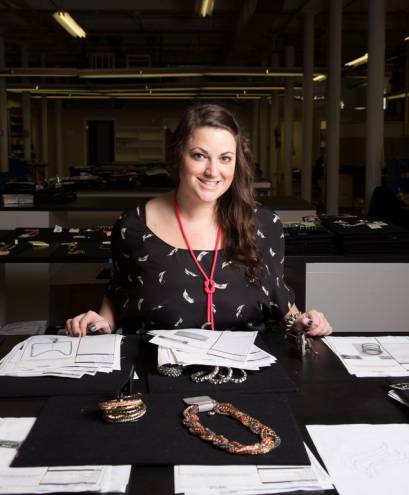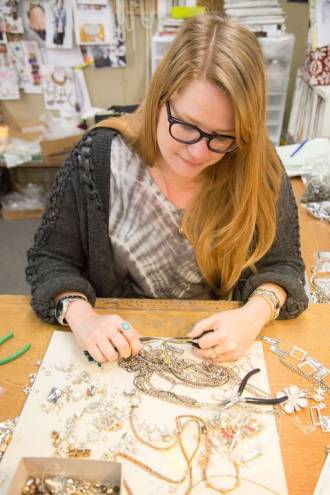These days we proudly call Providence the “Creative Capital” or the “Renaissance City,” but once upon a time it was known as the “Beehive of Industry.” From the end of the Revolutionary War right on through the Depression, Providence was one of the country’s industrial powerhouses; hard as it may seem to believe now, for a time it was one of the wealthiest cities in America. One of the main engines of our city’s industrial-economic boom was the jewelry industry. In the 1880s, Rhode Island was the number one state for jewelry manufacturing, accounting for one quarter of the entire country’s production.
In the last century, manufacturing of most products in most states was shipped overseas. Providence’s economic base began to crumble as factories went dark. And the jewelry industry was no different. Now it’s simply a long-gone part of our industrial legacy and most of the factories have been reborn as mixed-use redevelopments. Even the Jewelry District is being rebranded as the “Knowledge District.” The industry is gone... right?
Wrong. You could, however, be forgiven for thinking otherwise. Jewelry manufacturing employs approximately 7,500 people throughout the state, down from 32,500 at the height of the industrial boom. The Rhode Island Department of Labor and Training projects that between 2008 and 2018 the number of jobs in the category of “jewelers, precious stone workers and metal workers” will shrink from 1,246 to 961. However, grim statistics like that must be looked at in a larger context. Manufacturing as a whole is a much smaller part of the American economy. While jewelry is no longer the state’s largest industry, it still ranks a respectable third behind health care and tourism.
There are still about 870 companies that live off jewelry, whether it’s directly – design, manufacturing, wholesale – or indirectly, in the form of services and support like shipping, display cases and packaging. Speidel, one of the legacy companies from the state’s jewelry hey-day, is based in Cranston. Swarovski, a global luxury brand based in Austria, maintains its North American headquarters in Cranston as well. And then, of course, there’s the upstart that everyone’s talking about, Alex and Ani (more on them later).
The fact is, the jewelry industry in and around Providence certainly isn’t what it used to be, but it’s a whole lot better than you probably think it is – and it still has global reach. From the traditional shop floors where largely immigrant workers are assembling costume jewelry and affixing it to cards, to big time brands like Alex and Ani and Swarovski, design houses that keep a deliberately low profile while selling to major clients worldwide, and creative young designers selling their handcrafted stuff on Etsy while working day jobs; Providence is still an industry leader – and that’s barely scratching the surface.
Hidden in Plain Sight
I’m sitting in a handsomely appointed apartment on the West Side with three women in their late ‘20s/early ‘30s. They’re friends – they all live within a few blocks of each other, they frequent the same bars, and two of them are leaving for a vacation in Mexico together the next morning – but they’re also competitors. They’re all designers for different jewelry companies around the Providence area.
Erin Myles works for Bernardo Manufacturing in Rumford. Shara Spelkoman is with Accent Fashion Accessories in North Providence. And Libby Hodgkins designs for Arden Jewelry Manufacturing in Johnston. Unlike most people in their social circle and general demographic, they’re all enthusiastic about their current jobs and career prospects: they enjoy the work they do, feel they’re fairly compensated for it and see room for growth.
“We live in an artist town where people are scraping to get by. Our health care is awesome. We have lots of benefits. The money is more than decent. I think we’re all in the top earning tier of our social circles,” explains Spelkoman (pictured below), adding with a laugh, “that’s not saying much.” 
Despite the abundant opportunity they see in their industry, all three sort of lucked into it. They all arrived in Providence from elsewhere: Spelkoman from New Jersey, Hodgkins from Georgia, and Myles from nearby Attleboro. But none of them came here (if you’ll excuse the pun) by design.
Spelkoman took the most unique path. She came to study fashion merchandising at Johnson and Wales. Her entrée into the industry was through a school externship with a Thayer Street retailer, who then left her boutique to go into jewelry. Spelkoman followed, learning the tools and techniques of her newfound trade on the fly. She took to it quickly and was recruited for the gig with almost no experience or training. “I got my job before I graduated,” she recalls. “I was taking my lunch break to hand in term papers.”
Hodgkins and Myles, on the other hand, both went to school for metal smithing and jewelry making (at Savannah College of Art and Design and UMass Dartmouth respectively). However, it wasn’t Providence’s reputation as an industry hotbed that brought them here – they just happened to find jobs with local companies. “I knew there had been a huge jewelry industry here, but I was a metal smithing major and I barely knew this existed,” says Myles. Hodgkins adds, speaking of Myles’ college advisors, “If you live in this tri-state area and they didn’t tell you about this, they suck.”
The fact is, for an industry with such potential, surprisingly little is being done to herald it, and its drawing power is not being harnessed. While there are state and city level efforts to attract new talent in the “meds and eds” sector, no one seems to be promoting jewelry. “None of us knew this job existed for us,” admits Spelkoman. “I don’t think there is anyone being taught to design like we do. It’s all trial and error.”
This is at least partly due to the surprising level of secrecy under which most of these jewelry makers operate – their successes aren’t being touted because these companies are tightlipped. While all three women were more than happy to discuss their own personal careers, they were reluctant to reveal much about their employers – especially the names of their clients. This is because it’s a hyper-competitive industry in which companies are constantly trying to poach each other’s designs, customers and employees. “People hope you stick around forever in these companies, but no one expects you to,” says Spelkoman. “It’s the only industry I’ve ever seen where you can leave in the middle of something and they welcome you back three years later for twice as much money. I still get emails from headhunters twice a week. You can almost always make a move.”
Spelkoman’s Accent Fashion Accessories is the upstart of the bunch, in business, and she was the company’s first hire. In her seven-year career, she’s moved around several times. This contrasts sharply with Hodgkins, who moved here seven years ago to take a job with Arden and has remained there ever since.
 The company itself is over 75 years old, and Hodgkins (pictured at left) works alongside people who have been with it for ages, including a woman named Dottie, who recently celebrated her 80th birthday. Arden was her first job as a teenager. Bernardo, where Myles works, is also a family company entering its fouth generation.
The company itself is over 75 years old, and Hodgkins (pictured at left) works alongside people who have been with it for ages, including a woman named Dottie, who recently celebrated her 80th birthday. Arden was her first job as a teenager. Bernardo, where Myles works, is also a family company entering its fouth generation.
These companies maintain low profiles in part because their customers demand it. They’re designing and manufacturing for national and international retailers who are buying pieces in orders of tens of thousands and want to put their own brand names on them. Though the designers can’t brag about who they’re selling to, they’re more than happy to boast about who has worn their stuff. “We’ve all seen our work in fashion magazines, in movies, on TV,” explains Hodgkins. “We’re designing for people who are buying thousands of pieces, so you’re bound to see somebody wearing it.” For her part, she spotted one of her pieces on Mila Kunis in Black Swan. Spelkoman has seen one of her designs on American Idol. Myles boasts of seeing one of hers on Jane Krakowski in an episode of 30 Rock, but the other two are quick to offer some good-natured harassment about one of her necklaces being a fixture around the neck of a contestant on VH-1’s reality TV trashfest Rock of Love.
What these companies do for the most part is make original samples, which are then purchased by retailers – sometimes from company-owned showrooms in New York, sometimes on spec, sometimes after many rounds of back-and-forth with designers – and replicated many times over.
Traci Maceroni, a third generation owner of Bernardo, explains how it works: “The design process begins with close relationships with our merchants and our design teams. It starts conceptually with sketches and renderings. Our skilled model and mold makers take these paper patterns and bring them to life in a three-dimensional metal form. All our samples are designed and executed here. Bernardo is full fledged manufacturing plant on all levels. Every step is completed on the premise with the exception of plating.” That level of institutional know-how keeps these companies in business.
When it comes to large-scale manufacturing, however, cost is king. Bernardo says that back in the ‘70s and ‘80s it was all made here, but admits, “At present, we can no longer afford to manufacture domestically and remain competitive, so most of our production goes overseas to Asia.” Spelkoman, too, estimates that about 80% of Accent’s products are made in China, with probably another 15% in India.
While these designers are proud of the work they’re doing, they also have no illusions about it. All three are emphatic that they don’t consider themselves artists, noting that people in their line of work who do so typically don’t last. “At the end of the day, if Walmart wants you to make a piece smaller and darker and completely different, and they want to order 300,000 of them, you give it to them,” maintains Spelkoman. “You can’t get attached.”
That lack of fine art aspiration, however, is also what keeps them in business. Spelkoman continues: “Our companies all thrive even when the economy goes to shit. You can’t afford to go all out, but you can afford to do something little for yourself. Costume jewelry is a way to do that without breaking the bank. It’s why when the unemployment rate in this state is so terrible, we can still ask for raises.”
Comments
No comments on this item Please log in to comment by clicking here